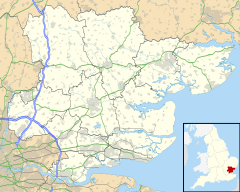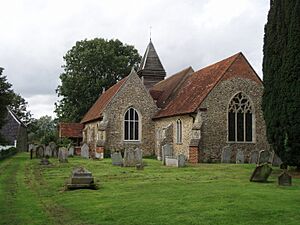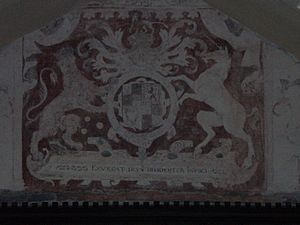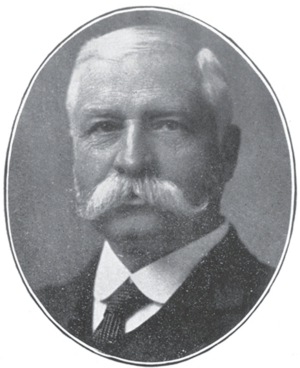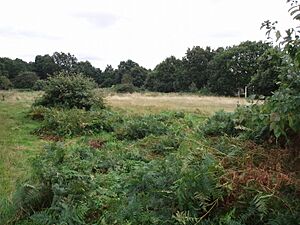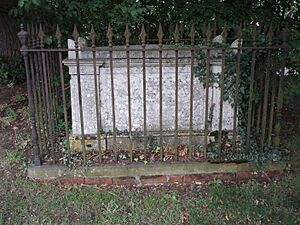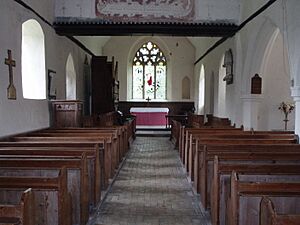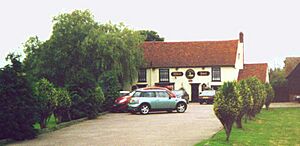West Bergholt facts for kids
Quick facts for kids West Bergholt |
|
|---|---|
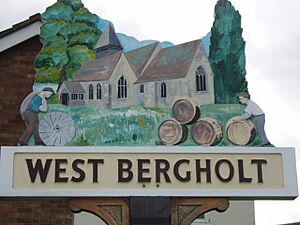 |
|
| Population | 3,344 (2011) |
| OS grid reference | TL965270 |
| District |
|
| Shire county | |
| Region | |
| Country | England |
| Sovereign state | United Kingdom |
| Post town | Colchester |
| Postcode district | CO6 |
| Dialling code | 01206 |
| Police | Essex |
| Fire | Essex |
| Ambulance | East of England |
| EU Parliament | East of England |
| UK Parliament |
|
West Bergholt, once called Bergholt Sackville, is a large village in Essex, England. It's close to the border with Suffolk and near the old town of Colchester. This village has a long history, going back to the medieval period. Today, it's part of the Colchester Borough Council area. In 2008, West Bergholt won third place in the "Best Kept Village in Essex" contest!
Contents
- Exploring West Bergholt Village
- A Look Back at West Bergholt's History
- How West Bergholt is Governed
- Important Buildings in West Bergholt
- Village Life Today
- Getting Around: Transport
- See also
Exploring West Bergholt Village
The village is built around a main triangle of roads: Colchester Road, Chapel Road, and Lexden Road.
Nature and Wildlife Around the Village
Around West Bergholt, you'll find many farms and large areas of woodland. One special place is Hillhouse Wood, also known as Bluebell Wood. The Woodland Trust bought this wood with help from local people. You can enjoy many walks through the wood. Sometimes, you might even spot different kinds of deer living there.
Village Shops and Services
In the past, West Bergholt had a butcher shop called Elmer's. There was also a general store named Digby's. This store is now an East of England Co-operative Society shop. Mr. Digby's son used to drive a local bus service to Colchester.
A Look Back at West Bergholt's History
Ancient Times in West Bergholt
People have lived in the West Bergholt area for a very long time. Finds from prehistoric times, the Iron Age, and the Roman period show this. These items were found near West Bergholt Hall, St. Mary's church, and other nearby spots. Some discoveries include ancient axes from the heath and Roman pottery and coins.
In 1977, archaeologists dug up a Bronze Age burial site. They found seven circular ditches, which were likely where mounds once stood. These mounds held cremation burials in pots. Some cremations were of children. They also found Neolithic tools like scrapers and blades. The pottery found shows the site was used between 1500 and 1000 BC.
The Normans Arrive
The Normans came to the village in 1067, after their conquest of England in 1066. The Anglo-Saxons had already named the village "Bergholta." This name means "wood on a hill," likely referring to Hillhouse Wood. The village already had a wooden church where the "Old Church" stands today.
In 1066, about 27 people lived in the village. By 1086, there were probably 32. In 1377, only 105 people paid the poll tax. Before the Normans, two landowners, Leofwin Croz and Alfays Goding, owned the village. They were replaced by Norman barons, Roger de Poitou and Richard fitz Gilbert. Roger de Poitou lost his land after rebelling against King Henry I. Richard fitz Gilbert kept his land because he supported the King.
The Sackville Family and Bergholt Sackville
The village changed its name to Bergholt Sackville in 1119. This happened after Robert Sackville became the Lord of the Manor. The Sackville family came to England with the Normans. Robert was a friend of King Henry I and fought for him in 1106. He was also the first official rector of St. Mary's Church. He gave a large estate in the village to St John's Abbey of Colchester. This estate was run by the Almery Priest, who used the profits to help the poor. Over time, this farm became known as Armoury Farm.
After King Henry VIII closed the monasteries, the estate was sold. But it was later bought back by the Sackville family.
Challenges with the Crown
Bergholt didn't always have good relations with the King. During King John's rule, Jordon Sackville had his land taken away. This was because he was a rebel baron. However, when King Henry III became king, Jordon got all his land back.
Later, Jordon's grandson, also named Jordon, joined a revolt against King Henry III. He was captured but pardoned because the King was friends with his grandfather. The Sackville family continued to hold the manor for many years.
By 1327, Bergholt was one of the poorest parishes in the Lexden Hundred. But then, the cloth industry grew, bringing wealth to the village.
Cloth Trade and Village Life
By the 16th century, West Bergholt was part of the growing cloth trade. Many villagers worked in cleaning and spinning wool. A law in 1557 tried to stop cloth making outside market towns. This would have hurt Bergholt. So, Bergholt joined with other villages to ask Parliament to change the law. They succeeded, allowing them to continue their cloth businesses.
In 1565, Thomas Love died. He founded Love's Charity and left money to help the poor of the village.
Trouble at the Church
Queen Elizabeth I had to step in twice to solve problems with the village vicars. One vicar, Reverend Edmund Tarrell, spent too much time in pubs. He even missed church services and failed to give last rites to a woman. Later, Reverend Richard Kyrby refused to hold services in English, wanting to keep them in Latin. He was tried for treason but the case was dropped. Sixteen years later, the Queen had him removed.
To remind everyone who was king, King James I had his royal coat of arms painted in the Church. You can still see it today. It has a motto from Psalm 68: "Let God arise and let His enemies be scattered." Opposite this, there are Hanoverian arms from 1816.
Civil War and Local Beliefs
During the English Civil War, the village seemed to support the Parliamentarians. The vicar, Gregory Holland, was accused of being a Royalist. He was allowed to stay but had to get a nonconformist curate to help him. Some villagers, like Samuel Skillingham, were even jailed for expressing Quaker beliefs.
The Lord of Bergholt Manor during the Civil War was Sir John Denham, a poet and Royalist spy. His property was sold to his political opponent, Sir Harbottle Grimston, 2nd Baronet.
Agnes George and Religious Freedom
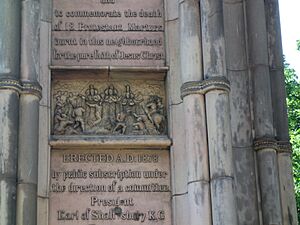
In 1556, a villager named Agnes George faced trouble with Queen Mary. Agnes refused to attend church because she disagreed with the Roman Catholic traditions. She was tried and imprisoned. Agnes wrote a letter criticizing the Pope and refusing to believe in the Catholic view of the bread and wine. She was executed in Stratford. In 1879, a monument was built in Stratford to remember her and others.
Agnes's husband, Richard, was also arrested. He escaped execution, but his second wife, Christine, was executed for her beliefs. They were held in Colchester Castle and executed in Colchester.
Later, Richard George and other Protestants were arrested again. They were sent to London for trial. They were eventually set free after agreeing to a compromise of faith. However, Richard and his wife were rearrested. Luckily for them, Queen Elizabeth was crowned while they were in prison. She ended the persecution of Protestants, and they were set free.
The King's Wrath and Thomas Abell
In 1540, Thomas Abell, who grew up in West Bergholt, faced serious trouble. He was the chaplain to King Henry VIII's first wife, Catherine of Aragon. King Henry wanted to divorce Catherine to marry Anne Boleyn. Thomas Abell argued against the King's divorce. After seven years in the Tower of London, he was sentenced to death. You can still see a carving he made on his prison wall in the Tower of London. He was later honored by Pope Leo XIII as one of the English Martyrs.
West Bergholt's Modern Growth
Records show that the village's largest pub, The White Hart, existed by 1725. It's still open today. In the past, there were many alehouses, and some were fined for illegal brewing or games.
The White Hart was a popular spot for farmers. This led to the creation of buildings nearby, known as the Crescent. These buildings included a brewery, a chapel, a wheelwright's, and a blacksmith's shop. Today, they are all homes.
The Village Brewery
The Daniell family, who lived in Colchester, started brewing beer in the 18th century. Thomas Daniel first made beer for his farm workers. It became so popular that he sold it around the village. In 1859, his sons expanded the business. The company grew strong and became a public company in 1886.
A big event for the brewery was when Osmond Orpen joined the family. He was known as a great brewer and became the Daniells' head brewer. Osmond had a huge impact on the village. He created jobs and helped the village grow. He also ran the parish council and helped the poor. In his will, he and Lorkin Daniell gave land and money for the village hall (Orpen Memorial Hall) and playing fields.
The village grew quickly, bringing more shops and builders. Grocers, butchers, bakers, and other trades were set up by 1851. One builder, Alfred Diss, employed many carpenters and bricklayers. A lasting improvement from the brewery's legacy was the installation of mains water in the 1930s. Later, sewage systems were added in the 1950s. Before this, the village used shallow wells and springs.
The brewery faced losses in 1958 and was sold to another company. It was used as a bottling plant and transport depot before being converted into flats in 1989.
Changes in Farming and Protests
In the 1840s, the village changed a lot due to the British Agricultural Revolution. Two major changes were enclosure (dividing up common land) and the use of machines in farming.
In the early 16th century, too many animals grazed on the common lands. Rules were made to control grazing. People also started building cottages illegally on the common land. By the mid-18th century, many of these buildings were allowed if registered.
Enclosure happened in Bergholt in 1865. The Heath was divided into new areas. Old paths were closed, and new roads, like Chapel Road, were built. Four acres of land were given to the poor for allotments, and another four acres for recreation (known as the Poor's Field). This land was managed by the Churchwardens. A third area was set aside for a new church and graveyard, as the old church was far from the village center. The rest of the land remained as Heathlands, where villagers could graze their goats.
The agricultural revolution also brought problems. Many farm workers lost their jobs after a war in 1815 and new poor laws. Machines made things worse. This led to groups of unemployed people, sometimes causing trouble. In 1842, the village saw protests, with fires being set. Farmers like Robert Bradbrook and Thomas Daniell were victims.
One fire in 1843 at Hightrees Farm killed animals and burned hay. It was so big it could be seen from Colchester. The police had trouble finding the people responsible because many villagers supported them. However, in 1843, Robert Woodward was found guilty of setting fires and sent to Australia for life.
Sports in the Village
During this period, the village Cricket Club was founded. The first recorded cricket match in the village was in 1831. The Essex County Standard reported great interest in the game, despite bad weather. Essex won the match. By the 1940s, the club moved to its current location on Manor Road.
A football club wasn't formed until 1911. It was nicknamed The Brewers and played friendly matches on the cricket ground. The current West Bergholt FC was founded in 1938. It became stable enough to join a league, playing on the Memorial Field. The club's first success was winning the Border League Division 2 in 1981.
Education for All
By the 19th century, West Bergholt had a school where students paid fees. But there was no school for poor children. The vicar, Reverend William Sims, tried to get funding for a school for the poor. He raised some money but died before the school was built. His son, Frederick Sims, became the next vicar and raised enough money from public donations.
The school was built on the Heath and could hold 200 students. Two cottages were built next to it: one for the schoolmaster and his wife, and the other to be rented out to help pay for the school's upkeep. The opening ceremony was held at the parish church.
How West Bergholt is Governed
West Bergholt is part of an electoral ward called West Bergholt and Eight Ash Green. In 2011, about 5,074 people lived in this ward.
Important Buildings in West Bergholt
Today, there is one active church, St. Mary's Anglican Church. The West Bergholt Methodist Church is no longer active and has been sold. The village also has a third church, also called St. Mary's, which is not used for regular services. This church, known locally as "St Marys' Old Church," used to be in the center of the village. Over time, the village grew away from it. It is still a sacred place and is cared for by the Churches Conservation Trust.
This old church has changed over many years. Some parts date back to the 11th century. You might even spot reused Roman bricks in its walls! There's also ancient graffiti from pilgrims who visited long ago. The church is located at the end of a farm track and is on the Essex Way long-distance footpath. It has a small graveyard with interesting old headstones.
Village Life Today
The village has two public houses (pubs) and a social club. These are the White Hart, the Queens Head, and the West Bergholt Social Club.
Religion in West Bergholt
West Bergholt has three active churches. St Mary's Anglican Church and the Methodist Church have their own buildings. The Pentecostal Fellowship meets at the Orpen Hall.
Getting Around: Transport
West Bergholt is served by several bus services, making it easy to travel to and from the village.
See also
 In Spanish: West Bergholt para niños
In Spanish: West Bergholt para niños


